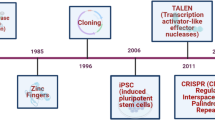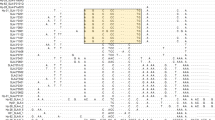Abstract
Members of the caveolin family played important roles during fundamental cellular processes, such as regulation of cell morphology, migration, and gene expression in muscle cells. In this study, caveolin-1 (Cav-1), one of the caveolins, was identified from longissimus dorsi muscle of Large Yorkshire pig and Chinese indigenous Lantang pig based on the results of mRNA differential display analysis. The deduced amino acids sequence of the porcine Cav-1 contained a caveolin domain, and was very conservative among different species. The Cav-1 mRNA was widely expressed in the eight tissues in this study, including heart, liver, kidney, encephalon, spleen, lung, longissimus dorsi muscle, and back fat, and the highest expression quantity was found in back fat of the two pig breeds. The expression quantity of porcine Cav-1 in back fat and longissimus dorsi muscle of Lantang pig was significantly higher than that of Large Yorkshire (P<0.01, and P<0.05, respectively). These results suggested that the Cav-1 might be a candidate gene for carcass traits, and might provide valuable information for understanding the mechanism of caveolae signaling in fat deposition by using the animal model of pig.
Similar content being viewed by others
References
Parton R G. Caveolae and caveolins. Curr Opin Cell Biol, 1996, 8(4): 542–548, 8791446, 10.1016/S0955-0674(96)80033-0, 1:CAS:528:DyaK28Xks1Gquro%3D
Grande-Garcia A, Echarri A, de Rooij J, et al. Caveolin-1 regulates cell polarization and directional migration through Src kinase and Rho GTPases. J Cell Biol, 2007, 177(4): 683–694, 17517963, 10.1083/jcb.200701006, 1:CAS:528:DC%2BD2sXls1ygsrY%3D
Fielding C J, Fielding P E. Relationship between cholesterol trafficking and signaling in rafts and caveolae. Biochim Biophys Acta, 2003, 1610(2): 219–228, 12648776, 10.1016/S0005-2736(03)00020-8, 1:CAS:528:DC%2BD3sXitFantb8%3D
Lisanti M P, Tang Z, Scherer P E, et al. Caveolae, transmembrane signalling and cellular transformation. Mol Membr Biol, 1995, 12: 121–124, 7767370, 10.3109/09687689509038506, 1:CAS:528:DyaK2MXmsFCjtb4%3D
Okamoto T, Schlegel A, Scherer P E, et al. Caveolins, a family of scaffolding proteins for organizing “preassembled signaling complexes” at the plasma membrane. J Biol Chem, 1998, 273(10): 5419–5422, 9488658, 10.1074/jbc.273.10.5419, 1:CAS:528:DyaK1cXhslejsbc%3D
Williams T M, Lisanti M P. The Caveolin genes: From cell biology to medicine. Ann Med, 2004, 36: 584–595, 15768830, 10.1080/07853890410018899, 1:CAS:528:DC%2BD2MXpsFWlsg%3D%3D
Engelman J A, Zhang X L, Lisanti M P. Sequence and detailed organization of the human caveolin-1 and-2 genes located near the D7S522 locus (7q31.1). Fed Eur Biochem Soc, 1999, 448(2–3): 221–230, 1:CAS:528:DyaK1MXisV2nsrk%3D
Lin W W, Lin Y C, Chang T Y, et al. Caveolin-1 expression is associated with plaque formation in hypercholesterolemic rabbits. J Histochem Cytochem, 2006, 54(8): 897–904, 16585386, 10.1369/jhc.5A6869.2006, 1:CAS:528:DC%2BD28XntFWnu74%3D
Kawabe J, Okumura S, Nathanson M A, et al. Caveolin regulates microtubule polymerization in the vascular smooth muscle cells. Biochem Biophys Res Commun, 2006, 342(1): 164–169, 16480946, 10.1016/j.bbrc.2006.01.125, 1:CAS:528:DC%2BD28Xhs1Wmur4%3D
Sotgia F, Rui H, Bonuccelli G, et al. Caveolin-1, mammary stem cells, and estrogen-dependent breast cancers. Cancer Res, 2006, 66(22): 10647–10651, 17108100, 10.1158/0008-5472.CAN-06-2805, 1:CAS:528:DC%2BD2sXivVyqs78%3D
Trigatti B L, Anderson R G, Gerber G E. Identification of caveolin-1 as a fatty acid binding protein. Biochem Biophys Res Comm, 1999, 255(1): 34–39, 10082651, 10.1006/bbrc.1998.0123, 1:CAS:528:DyaK1MXhtlOrsrg%3D
Pol A, Luetterforst R, Lindsay M, et al. A caveolin dominant negative mutant associates with lipid bodies and induces intracellular cholesterol imbalance. J Cell Biol, 2001, 152(5): 1057–1070, 11238460, 10.1083/jcb.152.5.1057, 1:CAS:528:DC%2BD3MXhslGmurY%3D
Pol A, Martin S, Fernandez M A, et al. Dynamic and regulated association of caveolin with lipid bodies: Modulation of lipid body motility and function by a dominant negative mutant. Mol Biol Cell, 2004, 15(1): 99–110, 14528016, 10.1091/mbc.E03-06-0368, 1:CAS:528:DC%2BD2cXlsFSnsw%3D%3D
Ring A, Le Lay S, Pohl J et al. Caveolin-1 is required for fatty acid translocase (FAT/CD36) localization and function at the plasma membrane of mouse embryonic fibroblasts. Biochim Biophys Acta, 2006, 1761(4): 416–423, 16702023, 1:CAS:528:DC%2BD28XltFGjtrg%3D
Fielding C J, Fielding P E. Cholesterol and caveolae: Structural and functional relationships. BiochIm Biophys Acta, 2000, 1529(1–3): 210–222, 11111090, 1:CAS:528:DC%2BD3cXosFCgsb8%3D
Smart E J, Graf G A, McNiven M A, et al. Caveolins, liquid-ordered domains, and signal transduction. Mol Cel Biol, 1999, 19(11): 7289–7304, 1:CAS:528:DyaK1MXmvFeksbw%3D
Fielding C J, Fielding P E. Cholesterol and caveolae: Structural and functional relationships. Biochim Biophys Acta, 2000, 1529: 210–222, 11111090, 1:CAS:528:DC%2BD3cXosFCgsb8%3D
Kandror K V, Stephens J M, Pilch P F. Expression and compartmentalization of caveolin in adipose cells: Coordinate regulation with and structural segregation from GLUT4. J Cell Biol, 1995, 129(44): 999–1006, 7744970, 10.1083/jcb.129.4.999, 1:CAS:528:DyaK2MXlsFSktr0%3D
Munoz P, Mora S, Sevilla L, et al. Expression and insulin-regulated distribution of caveolin in skeletal muscle. Caveolin does not colocalize with GLUT4 in intracellular membranes. J Biol Chem, 1996, 271(14): 8133–8139, 8626501, 10.1074/jbc.271.14.8133, 1:CAS:528:DyaK28XitFart7k%3D
Li C S, Chen Y S, Wang C et al. Cloning and analysis of differentially expressed ESTs in swine muscle tissue. Sci China Ser C-Life Sci, 2006, 49(4): 342–348, 10.1007/s11427-006-2012-3, 1:CAS:528:DC%2BD28XhtVGitr3O
Livak K J, Schmittgen T D. Analysis of relative gene expression data using real-time quantitative PCR and the 2(-Delta Delta C(T)) Method. Methods, 2001, 25(4): 402–408, 11846609, 10.1006/meth.2001.1262, 1:CAS:528:DC%2BD38XhtFelt7s%3D
Kim J, Adam R M, Solomon K R, et al. Involvement of cholesterol-rich lipid rafts in interleukin-6-induced neuroendocrine differentiation of LNCaP prostate cancer cells. Endocrinology, 2004, 145(2): 613–619, 14563701, 10.1210/en.2003-0772, 1:CAS:528:DC%2BD2cXovFSgtQ%3D%3D
Fang P K, Solomon K R, Zhuang L, et al. Caveolin-1alpha and-1beta perform nonredundant roles in early vertebrate development. Am J Pathol, 2006, 169(6): 2209–2222, 17148682, 10.2353/ajpath.2006.060562, 1:CAS:528:DC%2BD2sXhvV2ntg%3D%3D
Dasari A, Bartholomew J N, Volonte D, et al. Oxidative stress induces premature senescence by stimulating caveolin-1 gene transcription through p38 mitogen-activated protein kinase/Sp1-mediated activation of two GC-rich promoter elements. Cancer Res, 2006, 66(22): 10805–10814, 17108117, 10.1158/0008-5472.CAN-06-1236, 1:CAS:528:DC%2BD2sXivVyqsb4%3D
Hnasko R, Frank P G, Ben-Jonathan N, et al. PV-1 is negatively regulated by VEGF in the lung of caveolin-1, but not caveolin-2, null mice. Cell Cycle, 2006, 5(17): 2012–2020, 16969073, 1:CAS:528:DC%2BD28XhtlWqsLjF
Ahn M, Kim H, Matsumoto Y, et al. Increased expression of caveolin-1 and-2 in the hearts of Lewis rats with experimental autoimmune myocarditis. Autoimmunity, 2006, 39(6): 489–495, 17060028, 10.1080/08916930600929321, 1:CAS:528:DC%2BD28Xhtlagu7vN
Kuo C T, Leiden J M. Transcriptional regulation of T lymphocyte development and function. Annu Rev Immunol, 1999, 17: 149–187, 10358756, 10.1146/annurev.immunol.17.1.149, 1:CAS:528:DyaK1MXjtVSrtb4%3D
Cohen A W, Hnasko R, Schubert W, et al. Role of caveolae and caveolins in health and disease. Physiol Rev, 2004, 84(4): 1341–1379, 15383654, 10.1152/physrev.00046.2003, 1:CAS:528:DC%2BD2cXovVyltb0%3D
Ortegren U, Yin L, Ost A, et al. Separation and characterization of caveolae subclasses in the plasma membrane of primary adipocytes; segregation of specific proteins and functions. FEBS J, 2006, 273(14): 3381–3392, 16803459, 10.1111/j.1742-4658.2006.05345.x
Razani B, Combs T P, Wang X B, et al. Caveolin-1-deficient mice are lean, resistant to diet-induced obesity, and show hypertriglyceridemia with adipocyte abnormalities. J Biol Chem, 2002, 277(10): 8635–8647, 11739396, 10.1074/jbc.M110970200, 1:CAS:528:DC%2BD38XitFymu70%3D
Newcom D W, Stalder K J, Baas T J, et al. Breed differences and genetic parameters of myoglobin concentration in porcine longissimus muscle. J Anim Sci, 2004, 82: 2264–2268, 15318723, 1:CAS:528:DC%2BD2cXmtFeltLs%3D
Zuo B, Xiong Y Z, Deng C Y, et al. Polymorphism, linkage mapping and expression pattern of the porcine skeletal muscle glycogen synthase (GYS1) gene. Anim Genet, 2005, 36(3): 254–257, 15932409, 10.1111/j.1365-2052.2005.01286.x, 1:CAS:528:DC%2BD2MXlvVGns7k%3D
Cameron P L, Ruffin J W, Bollag R, et al. Identification of caveolin and caveolin-related proteins in the brain. J Neurosci, 1997, 17(24): 9520–9535, 9391007, 1:CAS:528:DyaK2sXotVWgsL0%3D
Oka N, Yamamoto M, Schwencke C, et al. Caveolin interaction with protein kinase C. Isoenzyme-dependent regulation of kinase activity by the caveolin scaffolding domain peptide. J Biol Chem, 1997, 272(52): 33416–33421, 9407137, 10.1074/jbc.272.52.33416, 1:CAS:528:DyaK1cXhtVahtg%3D%3D
Author information
Authors and Affiliations
Corresponding author
Additional information
Contributed equally to this work
Supported by National Natural Science Foundation of China (Grant NO. 30300249), Key Project of Chinese National Project for Fundamental Research and Development (973 Project) (Grant NO. 2004CB117506), and Group Project of Guangdong Natural Science Foundation (Grant NO. 04205804)
Rights and permissions
About this article
Cite this article
Wang, C., Mei, Y., Li, L. et al. Molecular characterization and expression analysis of caveolin-1 in pig tissues. SCI CHINA SER C 51, 655–661 (2008). https://doi.org/10.1007/s11427-008-0082-0
Received:
Accepted:
Published:
Issue Date:
DOI: https://doi.org/10.1007/s11427-008-0082-0




